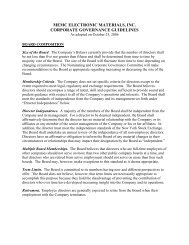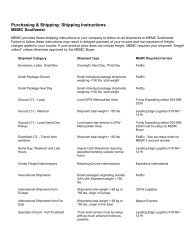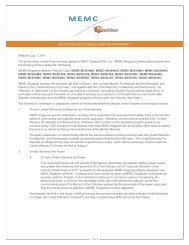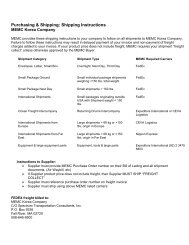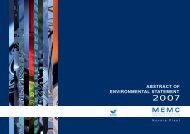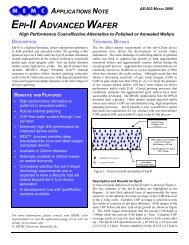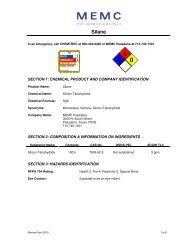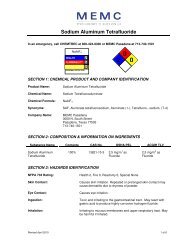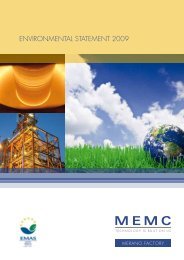MEMC_NO_04_ingl REV 04-06 - MEMC Electronic Materials, Inc.
MEMC_NO_04_ingl REV 04-06 - MEMC Electronic Materials, Inc.
MEMC_NO_04_ingl REV 04-06 - MEMC Electronic Materials, Inc.
- No tags were found...
You also want an ePaper? Increase the reach of your titles
YUMPU automatically turns print PDFs into web optimized ePapers that Google loves.
ABSTRACT OFENVIRONMENTAL STATEMENTYEAR 20<strong>04</strong><strong>NO</strong>VARA PLANT
General description of the activity<strong>MEMC</strong> <strong>Electronic</strong> <strong>Materials</strong> is amultinational group active in themicroelectronics sector in so far asthey produce highly pure silicon.The site at Novara receivesmono-crystal silicon bars from theMerano site or from other sites ofthe group.The transformation consists of theproduction of “wafers” very thinwafers of silicon with a width of lessthan 1mm. These are destined forthe construction of semi-conductorsand principally integrated circuits.2
Sites throughout the worldThe head office of the multinationalgroup can be found in St. Peters,Missouri (USA). There are a totalof 9 productive sites throughoutthe world. These are situated inAmerica, Asia and Europe andthey cover the whole globe withtheir commercial net.Productively <strong>MEMC</strong> is representedin Europe by <strong>MEMC</strong> <strong>Electronic</strong><strong>Materials</strong> S.p.A. with the sites atMerano and Novara. The last ofthese is the European head officeand is also the object of this environmentalstatement.On a world scale the group consistsof another five productive sites(Two in the USA, one in Japan, onein Malaysia and one in Taiwan,whose Memc has become the onlyowner in 2003) plus two joint ventureschemes with other partnersrespectively situated in the USA,Korea and Taiwan.Chonan City - KOREAHsinchu - TAIWANSherman TEXASKuala Lumpur - MALAYSIASt. Peters MISSOURIPasadena TEXASNovara - ITALYUtsunomiya City - JAPANMerano - ITALY3
A look at the historyThe construction of the <strong>MEMC</strong> siteat Novara was started in 1976.In the following years the site grewwith the construction of new officesand productive departments.October 2001, the group E.ONAg sold the ownership to a newmajor shareholder, an Americaninvestment company called TexasPacific Group.Novara plant in 1976<strong>MEMC</strong> Novara plant today4
General information about the site<strong>MEMC</strong> <strong>Electronic</strong> <strong>Materials</strong>S.p.ANovara siteViale Gherzi 31, 28100 NovaraAround 2.5 km north east of thetown centreInternet site: www.memc.comE-mail: info@memc.itTotal surface area: 79 385 m 2Covered area: 12 100 m 2Area of the car park: 10 800 m 2Annual underscore of the societyin 20<strong>04</strong> were 221 million.Number of employees: 892TURINA4ValsesiaSESIARiverTURINMILANS.S.11S.S.299A26 VOLTRISEMPIONEORTAlakeS.S.229<strong>NO</strong>VARAS.S.32S.S.211MAGGIORElakePaviaS.S.11TICI<strong>NO</strong>RiverMILANNACE code:DG24.13 - Production of otherchemical products withan inorganic baseISTAT activity code:24.130 - Production of otherchemical products with aninorganic baseCERTIFICATESAccording to internationalstandardsQUALITY SYSTEM:ISO9002 in 1991ISO9001 in 1994QS9000 in 1999ISO9001:2000 in 2003ISDTS16949 in 2003ENVIRONMENTAL SYSTEM:ISO14001 IN 1999EMAS in 2002(As at 31/12/<strong>04</strong>)EX M.T. BUILDINGDEIONIZEDWATERFACILITYEXHAUST DRUMSAND BOTTLESCLEANING POINTWASTE STORAGERECOVERABLE WASTE STORAGESTORAGE FLAMMABLE CHEMICALSSTORAGE CYLINDER STOCKAGEOUTSIDE CONTRACTCHEMICAL STORAGEOUTSIDE CONTRACTOR AREAWASTEWATER FACILITYCANTEENACID EMISSIONSTACKBUNKER HCLSAWING, LAPPINGAND POLISHINGDEPARTMENTSWIRESAW DEPARTMENTINFIRMARYOFFICESSTORAGEOFFICESCVD and EPIDEPARTMENTSSPECIAL GAS BUNKERMAINTENANCEGUARDHOUSE<strong>NO</strong>RTHVIA GHERZIENTRANCE5
Geographical positionand environmental backgroundNovara can be found in the northeast part of the region of Piemonte.Novara contains about 100.000inhabitants.The site is situated in the zone of St.Agabio, which is characterised bya mixture of industrial activity andresidential homes, according tothe census it’s the most populatedwith 11.950 inhabitants with a likelihoodof rising.The site can be found in amongsta chemical zone with many companieswhich have several differentproduction activities.PROVINCEOF <strong>NO</strong>VARAREGION OFPIEMONTEITALY6
<strong>MEMC</strong>’s commitment to the environmentThe companies’ commitmentis to improvingthe environment, andto reduce the risks connectedto its activities allthis is represented in thedocument “Companypolicy: Environment,Health and Safety”.7
The environmental Management Systemand the structure of the organisationThe realisation of the main ideas ofthe “Company policy: Environment,Health and Safety” have beenachieved thanks to the structuralorganisation described in the followingorganisation chart.During the first quarter of 2003some changement were occured;the President went in retairment andwas substituted by the Novara PlantDirection. This position was coveredwith the Operation Managerof each site: Novara and Merano,and the Tecnology manager ofNovara.<strong>MEMC</strong> <strong>Electronic</strong> <strong>Materials</strong> S.p.A.DIRECTOR AND BOARD CHAIRMANMANAGING DIRECTIONAssistantManaging Directionand Travel OfficesDirectorSupply Chain andInformation SystemManagerMerano PlantDirectorAmministration,Finance andControllingManagerOperation Tecnologyand EngineeringNovaraDirectorHuman ResourcesEuropeManagerNovara Operations<strong>MEMC</strong> <strong>Electronic</strong> <strong>Materials</strong> S.p.A. - Novara Plant<strong>NO</strong>VARA OPERATIONSManagerPurchasing andStoresManagerQuality AssuranceNovara ESH organisationESH STEERING COMMITTEEPresident <strong>MEMC</strong> S.p.A.Material Director, Tecnology Director,Novara and Merano plant DirectorsModificationManufactoringAreaMaintenancePlantFacilitiesEnvironment, Safetyand Health and SMSRepresentativeEnvironmental managementrepresentativePolishing&Cleaning Manufactoring AreaCVD&EPI Manufactoring AreaProduction Scheduling Control and ShippingOperationTecnology -ModificationOperation Tecnology and EngineeringAUTOMATIONEQUIPMENTOperation Tecnology - Polishing&CleaningOperation Tecnology - CVD&EPIIndustrialEngineeringPlantEngineeringESH COMMITTEEPlant DirectorTechnical Office ManagerPlant Facilities ManagerWaste Water Facility ManagerQuality ManagerHuman Resources and Training ManagerStorage ManagerPurchase Office ManagerMaintenance ManagerOperational Technology ManagersESH functionProduction area Manager8
Description of the activitiesIn the following flow chart the productivecycle of the site is described.MO<strong>NO</strong> CRYSTAL SILICON BAR(<strong>MEMC</strong> MERA<strong>NO</strong>)WIRE-SAWI.D. SAWLAPPINGCHEMICAL VAPOUR DEPOSITIONPOLISHING & CLEANINGEPITAXYWAFERSCUSTOMER9
Significant environmental aspectsOf the different activities carried outat the Novara site, some are associatedwith environmental aspectsthat actually or potentially, haveeither a direct or indirect effect asreported in the following table.ENVIRONMENTAL ASPECTSGENERATED IMPACTSEnergy consumptionWater consumptionRaw and auxiliary materialconsumptionEmissions to atmosphereWaste waterWasteAsbestosPCBOzone depleting chemicalsOdorsExternal noiseIonizing and not ionizing radiationSoil contaminationSoil usageLandscape modificationInternal and external transportationBiodiversity effectsNot renewable resources consumption (oil, natural gas, water, etc.)Atmosphere pollutant and global warmingWaste productionNot renewable resources (groundwater depauperation)Not renewable resources consumption and atmosphere pollutantSurface water pollutant, soil and groundwater contaminationAtmosphere pollutant and global warmingSurface water pollutantSoil and groundwater contaminationSoil occupationWater pollutantSoil and groundwater contaminationAtmospheric pollutantSoil and groundwater contaminationAtmospheric pollutantOzonosphere reductionOlfactory botherAtmospheric pollutantBotherHealth ailmentsSoil and groundwater contaminationSoil occupation, hydrogeologic alterationAtmospheric pollutant and global warmingNoise, vibrations, botherAtmospheric pollution, soil and groundwater contaminationFish fauna impoverishmentDamaging of riparil environmentDamaging of agriculture, green areas and woodlands10
To individualise the direct or indirecteffects of the production cycleon the external environment theenvironmental aspects associatedwith different activities have beensubjected to a significance evaluation.The results of the evaluationare reported in the followingtables.DIRECT ENVIRONMENTAL ASPECTSElectrical energy, steam and methan consumptionRaw material consumptionOil and combustible consumptionGroundwater consumptionDrinkable water consumptionnormalconditionsemergencyconditionspastconditionsAuxiliary materials consumption(for production, facility, shipping)Auxiliary materials consumption(for maintenance, storage, offices)Emissions to atmosphereDiffused emissionsWastewater dischargeCooling water, stormwater, civil wastewater dischargeHazardous waste (recoverable or not)Not hazardous waste (recoverable or not)PCBODS: Ozone depleting chemicalsAsbestosOdorsExternal noiseRadiationSoil contaminationSoil occupationLandscape modificationInternal transportationBiodiversity effectsvery significative significative not significative11
The quantification of the environmental effectsThe following graphs show thequantitative data for the significantenvironmental effects of the site.This data has been drawn up insuch a way so as to show the environmentalefficiency of the period1997 - 2001.This efficiency has been calculatedconsidering either the absolutevalue of the environmental aspector in specific terms, which referto the annual quantity of siliconwafers produced expressed inMSIE (Millions of equivalent squareinches).Shown below are data referredto the production of siliconexpressed in million square inches(MSIE) in the period considered.The data clearly outline the difficultmarket situation <strong>MEMC</strong> has had totake on in recent years: in 2001,the <strong>Electronic</strong>s industry was hit bythe worst market recession in thirtyyears, with inevitable repercussionson all the supply chain, includingsilicon producers, who suffered adrastic decline in orders, as testifiedto by the sharp contraction inproduction volumes experiencedalso by <strong>MEMC</strong> in 2001 versusthe previous years. The downsizingof production in line with themarket’s needs led to unavoidableeffects also on the management of“environmental” resources, whichhad been successfully optimisedfor higher production volumes.However, despite the adverseconditions, and although the situationstill hasn’t stabilised, <strong>MEMC</strong>’sreaction was positive already asof 2002, from the point of view ofboth production and environmentalperformance, as shown in the Chartbelow, and confirmed by the trendof the environmental indicators presentedfurther on in this document.ANNUAL PRODUCTION QUANTITY(MSIE referred to 1997,considered as base year)YEAR199719981999200020012002SILICON WAFERS PRODUCTION1401201008<strong>06</strong><strong>04</strong>02001997 1998 1999 2000 2001 2002 2003 20<strong>04</strong>YEAREnergy consumptionThe principle source of energy forthe site is electricity.The site also uses steam mainly forthe conditioning system, methane todry the sludge that comes from thepurification of the flow back anddiesel for the internal movement ofgoods.Total consumption (tep*)200320<strong>04</strong>electricalenergysteamoil andmethantep* tep* tep*13.800 2.224 3913.417 2.892 514.694 2.892 4815.269 3.003 21014.72514.9503.1853.35610510315.576 3.417 9316.192 3.432 196TOTAL ENERGY CONSUMPTION2000019000180001700016000150001997 1998 1999 2000TOTAL ENERGYCONSUMPTIONtep* tep*/MSIE**16.<strong>06</strong>4 9916.314 12017.634 11318.482 1<strong>06</strong>18.015 13118.409 10719.087 10019.820The value of energy consumptionfrom s<strong>ingl</strong>e sources, and the totalvalue, are reported in absoluteterms (TOE: tons of oil equivalent)and in specific terms, i.e. with referenceto the annual production quantitiesof silicon wafers (expressed inMSIE: millions of square inchesequivalent), both in the form oftables and charts.When analysing data referred tothe past three years, global energyconsumption emerges as having88*tep = equivalent tons of petroleumoil**MSIE = million square inchesequivalent2001 2002 2003 20<strong>04</strong>TotalSpecific1351251151059585Specific consumption (tep*/MSIE**)YEAR12
isen consistently, and not proportionallyto production increases:indeed, specific energy consumptiondeclined sharply, touching its lowestlevel since 1997.This results was achieved mostlythrough the optimisation of facilityand machinery management, withthe full exploitation of productionlines, conducive to the reduction offixed consumption levels.Diesel fuel consumption rose significantlyin 2003, due to the installationand use of a mobile boiler, toproduce the steam necessary for theupkeep of a number of the facility’splants for one week, during whichour supplier was forced to interruptsupplies in order to carry outextraordinary maintenance on theheating plant; consumption in 20<strong>04</strong>was significantly lower than in2003, and in any case in line withprevious years.The trend of natural gas consumptionwas irregular and tied tofunctioning of the drier: in 2003,the drier underwent extraordinarymaintenance, following a numberof failures since 2001, which ledto repeated temporary shutdowns.Apart from a one-month shutdownin 20<strong>04</strong> due to a fire, the drier hasfunctioned with greater continuity onthe whole, allowing natural gas consumptionlevels to decrease back tovalues in line with 2000.In any case, these changes haveonly a marginal impact on globalenergy consumption, as they arenegligible when compared to theconsumption of electricity.2nd water-bearing stratum1st water-bearing stratumtotal yearly consumptionspecific consumptionWater consumptionThe whole of the water supply forthe productive processes of the sitecomes from the four wells (2 in thefirst water-bearing stratum and 2in the second one) of groundwaterbeneath the site.The drinking water comes from thetown reservoir.The annual needs for industrialwater are an efficiency indicator forthe use of water resources. This isexpressed in the amount of groundwaterused for the annual productionof silicon wafers expressed inmillions of square inches.In 20<strong>04</strong>, a new second stratumwell, opened in 2003, was activatedin replacement of an existingwell no longer exploitable for technicalreasons.Total consumption (m 3 /year)YEAR199719981999200020012002200320<strong>04</strong>TOTAL WATER CONSUMPTION - INDUSTRIAL USE3.300.0003.000.0002.700.0002.400.0002.100.0001.800.0001.500.0001.200.000900.00<strong>06</strong>00.000300.000Tot. Annualm 3 /year2.335.7232.675.9842.688.9582.758.6012.622.1372.931.5343.027.6623.096.2931997TOTAL WATER CONSUMPTION - INDUSTRIAL USE(1 st and 2 nd water-bearing stratum wells)2 nd waterbearingstratumm 3 /year1.688.1421.992.3702.114.2092.2<strong>06</strong>.4692.162.9132.200.3602.299.0702.449.92019981 st waterbearingstratumm 3 /year647.581688.494574.749557.451745.021735.826733.095646.37319992000YEARThe table and the chart belowillustrate the trend of total waterconsumption, broken down by useand origin: 1 st and 2 nd water-bearingstratum. The distinction is madeas the characteristics of the waterdrawn from the two water-bearingstrata are different: the first islocated in the first soil stratum (ata depth of 4-30 metres) and istherefore more vulnerable to modificationsdue to anthropic activity.The second water-bearing stratum,on the other hand, is located at agreater depth (40-110 metres) andis purer, easier to preserve, giventhe distance from anthropic activityand possible sources of pollution.In fact, it is also drawn by thelocal water utility for use as drinkingwater. The phase of the proc-Specificm 3 /MSIE14.36019.63717.21215.89119.01416.9612001% (Yearly specificconsumptionAnnual- m 3 /year10013.65213727.63112035.01711130.52113223.998118 25.55320022003CIVIL WATERCONSUMPTION(town reservoir)15.879111 22.51913.755 96 20.22520<strong>04</strong>20.00015.00010.0005.0000Specific consumption (m 3 /MSIE)13
ess which required greater waterconsumption (2 nd water-bearingstratum) is the washing of siliconwafers (over 40% of total consumption).Data analysis total water consumptionfor industrial uses, as drawnfrom the water-bearing strata, to beon the rise in absolute terms, dueon the one hand to higher productionlevels in recent years, and onthe other to lower specific consumption,thanks to full exploitation ofthe production lines, which madethe processes more efficient in thecourse of the year from the point ofview of water consumption.Moreover, in the past three yearsthe following measures aimed atreducing water consumption havebeen put in place in some plants:• Reduction in the consumption ofdeionised water drawn from thesecond water-bearing stratum forfinal washing of the siliconwafers• Recovery of hot waste water fromthe above deionised water line,obtained from the second waterbearingstratum.Another efficiency indicator for thewater use is represented by therelationship between the quantityof water recycled divided by thequantity of water supplied: Qr/Qathis shows a reduction which showsthis indicator to have declined in20<strong>04</strong>. The decline is due to thefact that while the amount of waterdrawn rose, as a result of sharpproduction increases, the amountof recovered water did not increaseproportionally. Indeed, this water isused for cooling, smoke reduction,and container washing ends, whichrequired quantities of water notproportional to production.Water consumption is in any casea very important environmentalissue, as the amount of waterdrawn from the second water-bearingstratum was equal in total toaround one-sixth of the entire waterconsumption of the city of Novara.Therefore, consumption reductionmeasures have been identified forfuture implementation, with specialreference to the second water-bed;these measures are described ingreater detail in the “Improvements”section.% recovered water referred tototal groundwater consumptionRECOVERY OF GROUNDWATER2016128401998YEARRECOVERY OF GROUNDWATERQr(mc)/Qa(m 3 )Totalrecoveredwaterm 3 /yearTotalgroundwaterconsumption (Qr/Qa)*100m 3 /year1998199920000215.76<strong>04</strong>20.7612.680.8642.691.5592.763.920-8,0015,202001 459.790 2.627.059 18,902002 451.407 2.931.534 15,002003 467.908 3.027.662 15,5020<strong>04</strong> 461.201 3.314.123 13,921999 2000 2001 2002 2003 20<strong>04</strong>YEARQuintino Sella canal from the brige near <strong>MEMC</strong> plant%14
Consumption ofauxilary materialsThe productive process uses manydifferent chemical substances thathave an indirect environmentaleffect, where the production plantsare located, and a direct environmentalimpact, fully controllablefrom inside <strong>MEMC</strong>, in so far as theformation of polluting by-productsthat can be transferred to the air,water and soil.Several phases of the industrialprocess, carried out within the facility,require the use of hydrofluoricacid, classified as highly toxic inconcentrations of more than7%. Due to its storing and useof hydrofluoric acid, also mixedwith other acids, and of hydrogenchloride anhydrous, the facility isincluded in class “A2” of the relevantaccident risk classifiedon defined byItalian Legislative Decree 334/99.For this reason, a security managementsystem has been defined andimplemented, which integrated withthe environmental management systemintroduces improvements in themanagement of these substances,in order to reduce the risks associatedwith their use and storing. Thetable below shows the consumptiontrends of substances used on thefacility which are significant in termsof quantities (>3 tons/year) and dan-ger (classified as Toxic, Corrosive orEasily Flammable).The implementation of the newcaustic attack process, an improvementaction provided for in theEnvironmental Plan for 20<strong>04</strong>, led toa considerable rise in the consumptiontrend of potassium hydroxide(classified as corrosive) comparedto previous years; however, as thissubstance is used as an alternativeto acid attack, consumption of phosphonitricsolution and, more importantly,hydrofluoric acid (classifiedas highly toxic) dropped significantlyboth in absolute and specific terms,as shown on the table and chartbelow.AUXILARY MATERIALSHAZARDOUSTOTAL CONSUMPTION (t)SPECIFIC CONSUMPTION (t/MSIE)CLASSIFICATIONS 1999 2000 2001 2002 2003 20<strong>04</strong> 1999 2000 2001 2002 2003 20<strong>04</strong>Sodium hydroxide 30% Corrosive 724 951 795 884 902 1.074 4,19 5,50 4,60 5,12 5,22 4,77Potassium hydroxide 40%Hydrocloridric acid anidrous (gas)Hydrocloridric acid 37%CorrosiveToxic - CorrosiveCorrosive42377242910194219425387185,53176158,2488750,020,1325,70,030,1733,90,030,1231,30,030,2223,90,030,185,30,260,223,9Nitric acid 65% Corrosive43 34 18 14 13 13 0,25 0,20 0,10 0,08 0,07 0,<strong>06</strong>Pfosphoric, nitric andhydrofloridric acid mix(50%H<strong>NO</strong>3-10%CH3COOH-6%HF)Pfosphoric and nitric acid mix(37%H<strong>NO</strong>3-39%H3PO4)TrichlorosylaneIsopropylic alcoholToxicCorrosiveCorrosiveExtremely flammable - CorrosiveEasily flammable - Irriting666902253660582217236153617683444001892309,83603196339,8339381033,850,520,130,313,823,370,120,422,093,100,100,391,992,310,140,531,792,080,180,551,51,50,170,46CHROMIUM VI CONSUMPTIONYEAR Total Specific %kg kg/MSIE 1997 = 1001997 140 0,860 1001998 171 1,260 1461999 152 0,970 1132000200140320,2300,23027272002 46 0,270 312003 61 0,320 3720<strong>04</strong> 34 0,152 18Total consumption (kg)HEXAVALENT CHROMIUM (Cr VI + )2001501005001997 1998 1999 2000 2001 2002 2003 20<strong>04</strong>2,01,61,20,80,4-Specific consumption (kg/MSIE)YEARTotalSpecific15
Trends referred to substances onwhich specific improvement actionshave been focused are illustratedin dedicated tables and charts, forgreater clarity.Some of the tests carried out on siliconwafers to verify the absence ofdefects require acid attacks based onthe use of hexavalent chromium compounds,the only substance classifiedas cancerous among those used inthe facility.The table and chart illustrate thetrend of quantities consumed over theyears, which have declined thanksto the improvement actions put inplace. In particular, a chromium-freeattack solution had already beenintroduced for some tests, and in thepast year, thanks to process modifications,the execution of tests requiringchromic acid were carried out usingonly around one third of the amountof acid used in the past. This is aremarkable result, considering therecent need to increase the numberof chromic acid attacks, due to higherdemand from clients of a kind of siliconwafer which can only be testedwith chromic acid compounds.YEAR1997TOTAL HF 100%CONSUMPTIONkgSPECIFIC HF 100%CONSUMPTIONkg/MSIE74569 4581998199920002001622597707585838663054574934944812002 74254 4302003 84261 44220<strong>04</strong> 74467 391Total consumption (kg)CONSUMPTION OF CHEMICAL SUBSTANCES: HYDROFLUORIC ACID (HF)90.00085.00<strong>06</strong>0055080.00050075.00<strong>04</strong>5070.00<strong>04</strong>0<strong>06</strong>5.00035<strong>06</strong>0.0003001997 1998 1999 2000 2001 2002 2003 20<strong>04</strong>YEARSpecific consumption (kg/MSIE)SILICON CARBIDE CONSUMPTIONYEAR Total Specific %kg kg/MSIE 1998 = 1001998 132.600 1.241 1001999 94.100 839 682000200193.<strong>06</strong>095.86<strong>06</strong>7969555562002 248.540 1.438 1162003 147.860 775 6220<strong>04</strong> 132.800 590 47Total consumption (kg)CONSUMPTION OF CHEMICAL SUBSTANCES: SILICON CARBIDE240.000180.000120.00<strong>06</strong>0.0001998 1999 2000 2001 2002 2003YEAR3.0002.4001.8001.20<strong>06</strong>0020<strong>04</strong>Specific consumption (kg/MSIE)YEARABRASIVES FOR POLISHINGCONSUMPTIONTotal Specific %kg kg/MSIE 1998 = 1001997 300.000 1.844 1001998199920002001452.400368.295314.940201.8403.3202.3581.8141.46418012898792002 296.960 1.718 932003 281.880 1.478 8020<strong>04</strong> 276.260 1.227 37Total consumption (kg)CONSUMPTION OF CHEMICAL SUBSTANCES: ABRASIVES FOR POLISHING480.00<strong>04</strong>30.000380.000330.000280.000230.00<strong>04</strong>.0003.5003.0002.5002.0001.500Specific consumption (kg/MSIE)180.0001.0001997 1998 1999 2000 2001 2002 2003 20<strong>04</strong>YEARTotal Specific16
For what concerns other chemicalsubstances not classified as hazardous,but which have an environmentalimpact as at the end of the processthey are channelled to the wastewater purification plant in wastesuspensions, and take on the form ofsludge for recycling or disposal, wewill now analyse the abrasives usedin the cutting and polishing phases,already covered in our previousEnvironmental Plan.Thanks to the recovery of the abrasiveused in wire cutting phases (64%in 20<strong>04</strong>), the specific consumptionof silicon carbide purchased hasfurther decreased.The consumption of polishing abrasivesfollowed a similar trend: theimprovement actions put in place inrecent years have allowed a consistentreduction in the use of this chemicalsubstance, in both absolute andspecific terms.Lastly, the consumption trends ofchemical substances which havebeen the object of further improvementactions geared to limiting theiruse over the 2002-20<strong>04</strong> three-yearperiod are shown: ammonia andhydrogen peroxide. Consumption ofthese substances, used in washingphases, declined in the three-yearperiod, despite an increase in theabsolute consumption of hydrogenperoxide in the last year (as aresult of markedly higher productionloads compared to the two previousyears), while specific consumptionof the substance declined. Ammoniaconsumption remained broadly flat.These trends resulted from changesintroduced in the intermediate andfinal phases of the wafer washingprocess, aimed at increasing thequality of the wafers. However, theimprovement of this environmentalindicator is evident in both absoluteand specific terms, when a longertime horizon is considered.YEAR199725% AMMONIA SOLUTIONCONSUMPTIONTotal Specific %kg kg/MSIE 1997 = 10086.303 531 100199819992000200176.6461<strong>04</strong>.94784.54763.2305626724874591<strong>06</strong>12792862002 72.982 422 802003 53.559 281 5320<strong>04</strong> 66.190 294 55Total consumption (kg)CONSUMPTION OF CHEMICAL SUBSTANCES: 25% AMMONIA140.0001.100120.000900100.00070080.00050<strong>06</strong>0.00030<strong>04</strong>0.0001001997 1998 1999 2000 2001 2002 2003 20<strong>04</strong>YEARSpecific consumption (kg/MSIE)YEAR199730% HYDROGEN PEROXIDECONSUMPTIONTotal Specific %kg kg/MSIE 1997 = 10<strong>06</strong>9.501 427 1001998199920002001121.727134.745101.<strong>04</strong>192.3948938635826702092021361572002 89.459 518 1212003 74.990 392 9120<strong>04</strong> 79.367 353 83Total consumption (kg)CONSUMPTION OF CHEMICAL SUBSTANCES: 30% HYDROGEN PEROXIDE140.000120.000100.00080.00<strong>06</strong>0.00<strong>04</strong>0.0001997 1998 1999 2000 2001 2002 2003 20<strong>04</strong>YEAR1.100900700500300Specific consumption (kg/MSIE)TotalSpecific17
Emissions intothe atmosphereThe productive processes of the siteproduce, as a by-product, vapoursand gasses that collect in the exhaustducts. These are eventually brokendown, according to their typologyand danger level, before they arereleased into the atmosphere.The following graphs show thequantitative trend of the chemicalsubstances that are released into theatmosphere both absolute and standardisedto the annual production ofthe year in question. The legal limitsare also shown in the graph.These trends reveal a decline in theemissions of nitrogen oxides andhydrofluoric acid, achieved thanksto lower consumption of phosphonitricsolution and hydrofluoricacid in the implementation of thecaustic attack process. The trendsof the other substances, on the otherhand, remained flat over the threeyearperiod, and consumption levelsare comparable to those recordedin previous years. The only exceptionsare ammonia and hydrochloricacid, the emissions of which rosein the past year in line with theirincreased consumption.Nitrogen OxidesEMISSIONS INTO THE ATMOSPHERE - NITROGEN OXIDE: (<strong>NO</strong>x)YEARQuantityemissionLimit by law(by permit)Quantity specificemission(kg/h) (kg/h) (kg/MSIE)1997 3,31 4,5 178,0199819992000200120021,661,701,992,132,124,54,55,55,55,592,093,398,6123,71<strong>04</strong>,92003 2,43 5,5 110,020<strong>04</strong> 1,12 5,5 42,9Total emission (kg/h)6,05,55,<strong>04</strong>,54,03,53,02,52,01,51,01997 1998 1999 2000 2001 2002 2003 20<strong>04</strong>YEAR2502101701309050Specific emission (kg/MSIE)Hydrofluoric acidEMISSIONS INTO THE ATMOSPHERE - HYDROFLUORIC ACIDYEAR199719981999200020012002QuantityemissionLimit by law(by permit)Quantity specificemission(kg/h) (kg/h) (kg/MSIE)0,03300,03300,01540,01690,00740,02720,070,070,070,110,110,111,6201,8300,8470,8410,4311,3002003 0,0021 0,11 0,09520<strong>04</strong> 0,0021 0,11 0,081Total emission (kg/h)0,120,100,080,<strong>06</strong>0,<strong>04</strong>0,020,001997 1998 1999 2000 2001 2002 2003 20<strong>04</strong>3,22,92,62,32,01,71,41,10,80,50,2Specific emission (kg/MSIE)YEARHydrocloric acidEMISSIONS INTO THE ATMOSPHERE - HYDROCHLORIC ACID: HClYEAR199719981999200020012002QuantityemissionLimit by law(by permit)Quantity specificemission(kg/h) (kg/h) (kg/MSIE)0,03760,05280,03690,03400,<strong>06</strong>130,02670,1820,1820,1820,2470,2470,2472,032,932,031,693,551,302003 0,0087 0,247 0,3920<strong>04</strong> 0,<strong>04</strong>07 0,247 1,56Total emission (kg/h)0,300,250,200,150,100,050,001997 1998 1999 2000 2001 2002 2003 20<strong>04</strong>YEAR5,<strong>04</strong>,54,03,53,02,52,01,51,0Specific emission (kg/MSIE)18Total Specific Limit by law (by permit)
OzoneEMISSIONS INTO THE ATMOSPHERE - OZONEYEAR19981999200020012002200320<strong>04</strong>Quantityemission(kg/h) (kg/h) (kg/MSIE)0,008320,0<strong>06</strong>100,007800,02300not detectedLimit by law(by permit)0,1340,1340,3340,3340,334Quantity specificemission0,4620,3350,3901,330-0,0<strong>04</strong>90 0,334 0,2210,00300 0,334 0,115Total emission (kg/h)0,400,350,300,250,200,150,100,050,001998199920002001YEAR20022003-20<strong>04</strong>654321Specific emission (kg/MSIE)Isopropyl alcoholEMISSIONS INTO THE ATMOSPHERE - ISOPROPYL ALCOHOLYEARQuantityemissionLimit by law(by permit)Quantity specificemission0,530199719981999200020012002(kg/h) (kg/h) (kg/MSIE)0,12700,<strong>06</strong>400,<strong>04</strong>020,16300,32100,<strong>06</strong>560,3200,3200,3200,4550,4550,4556,843,552,218,0918,603,302003 0,1746 0,455 7,89Total emission (kg/h)0,40,30,20,10,0252015105-Specific emission (kg/MSIE)20<strong>04</strong> 0,1318 0,455 5,<strong>04</strong>1997 1998 1999 2000 2001 2002 2003 20<strong>04</strong>YEARAmmoniaEMISSIONS INTO THE ATMOSPHERE - AMMONIA: NH 3YEAR199719981999200020012002200320<strong>04</strong>QuantityemissionLimit by law(by permit)Quantity specificemission(kg/h) (kg/h) (kg/MSIE)0,4510 2,25 24,30,45500,75700,51702,252,252,5925,241,625,70,70900,75102,592,5941,137,20,2650 2,52 13,10,9631 2,52 47,7Total emission (kg/h)2,752,502,252,001,751,501,251,000,750,500,250,001997 1998 1999 2000 2001 2002 2003 20<strong>04</strong>75655545352515Specific emission (kg/MSIE)YEARYEAR199719981999200020012002QuantityemissionChromium VILimit by law(by permit)Quantity specificemission(kg/h) (kg/h) (kg/MSIE)0,0001000,00<strong>04</strong>000,0010000,000700not detectednot detected0,01500,01500,01500,02750,02750,02750,00540,02220,05500,0347--2003 0,000013 0,0275 0,00<strong>06</strong>20<strong>04</strong> 0,000003 0,0275 0,0001Total emission (kg/h)EMISSIONS INTO THE ATMOSPHERE - CROMIUM VI0,0320,0280,0240,0200,0160,0120,0080,0<strong>04</strong>0,0001997 1998 1999 2000 2001 2002 2003 20<strong>04</strong>0,300,250,200,150,100,05--0,05Specific emission (kg/MSIE)YEARTotal Specific Limit by law (by permit)19
EQUIVALENT CARBON DIOXIDEThe table and chart below showthe facility’s emissions expressed incarbon dioxide equivalent values,which represent the facility’s contributionto raising the temperature ofthe earth’s surface, a phenomenonknown as greenhouse effect, or globalwarming (GW).The trend reflects the facility’senergy consumption, and consumptionof R22 refrigerant, which is thechemical compound with the highestglobal warming coefficient (absoluteconsumption of the substancechanged little in 20<strong>04</strong> compared toprevious years, as no actions wereplanned in 20<strong>04</strong> to limit its use). Onthe whole, CO2 emissions increasedin absolute terms, following the correspondingrises in the consumptionof electricity, natural gas, diesel fueland R22; by contrast, the specificvalue, i.e. referred to the productionunit, reversed its trend, droppingbelow the levels recorded in recentyears. The drivers of these trends arethe same as described in the sectionon energy consumption.Calculation of the contributionto global warming is carried outassuming that all the electricity consumedby the facility is generated bythermoelectric power plants (whosecontribution to global warming issubstantial, as they burn fuel oil togenerate energy, emitting carbondioxide and other pollutants intothe atmosphere). In actual fact, onlypart of the energy consumed by thecompany, not accurately quantifiableat the present stage, is generatedby thermoelectric power plants,while the remainder is produced byhydroelectric plants, which do notcontribute to the greenhouse effect.Therefore, the values we have optedto provide, due to the lack of reliabledata on the exact sources ofthe energy consumed, represent thehighest possible contribution, andtherefore draw a worse picture comparedto the actual situation.As mentioned in the previous sectionon atmospheric emissions, inthe future the company will acquireall the electricity and steam requiredby the facility from a cogenerationYEARTotalSpecific Rif. to Spec.Total Electr.Energy Steam Methane Diesel oil R22 TotaltCO 2 tCO 2 tCO 2 tCO 2 tCO 2 tCO 2 tCO 2 /MSIE%19971998199920002001200249.09747.91752.59254.8<strong>06</strong>51.71954.21342.40841.22245.07<strong>04</strong>6.87<strong>04</strong>3.24<strong>04</strong>5.2976.6896.6957.4667.7558.2298.6710<strong>04</strong>71702432368781<strong>06</strong>90,800,800,600,600,500,173023523373153753141001161111<strong>04</strong>1241<strong>04</strong>2003 56.868 47.820 8.828 68 152 0,30 298 9920<strong>04</strong> 58.763 49.716 8.867 418 4 0,30 261 87Annual quantity (tonn)EMISSIONS OF CARBON DIOXIDE EQUIVALENT800007000<strong>06</strong>00005000<strong>04</strong>000030000200001000001997 1998 1999Eletric energyEMISSIONS OF CARBON DIOXIDE EQUIVALENTSteam2000YEARSpecificplant. This change will determine areduction in the emission and countof carbon dioxide driving fromenergy consumption, as cogenerationpower plants produce markedlylower emissions of carbon dioxide(the main cause of greenhouseeffect) than traditional fuel oil powerplants at like-for-like energy generated.2001 2002 200320<strong>04</strong>400350300250200150100500Specific quantity (tonn/CO 2MSIE)20
Waste waterWaste water from the various productionprocesses are channelled tothe facility’s waste water purificationplant, in function since mid 1997,in which pollutants are treated andpurified waters returned to the CavoVeveri irrigation canal, a confluentof the Terdoppio stream, wherecooling waters are also discharged.Meteoric waters are also channelledinto the same stream through separatepiping. Civilian discharges arechannelled to the Agogna streamthrough the municipal sewage system,after treatment in the municipalwater purification plant.Listed in the charts below are thecapacities of the different types ofdischarges, and the concentrationvalues (highest monthly averagerecorded in the year considered,calculated as the mathematical averageof the concentrations identifiedthrough internal analyses on samplesfrom each discharge, taken at leastthree times a week on alternate days)of the typical pollutants recorded atthe waste water’s purification plant’sdischarge. Also indicated are thelimits imposed by current legislation:as shown in the charts, these limitsare respected in all cases.YEARIndustrial waterdischargem 3 /yearINDUSTRIAL AND CIVIL WASTE WATER FLOWINDUSTRIAL WASTE WATER(Water pumped from 1 st and 2 nd groundwater wells)Waste water facilitydischargeCooling waterdischargeSpecific industrial waterdischarge% Annual specificconsumptionm 3 /year m 3 /yearm 3 /MSIE-CIVIL WASTE WATER(water supplied by municipal waterservice and 2 nd groundwater wells)Scarico Civilem 3 /year19981999200020012.675.9842.688.9582.758.6012.622.1371.957.2741.9<strong>04</strong>.1662.093.0011.951.817718.710784.792665.60<strong>06</strong>70.32019.63717.21215.89119.01410088819727.63135.01730.52123.9982002 2.931.5342.638.194 293.34016.962 86 25.5532003 3.027.6622.532.913 494.749 15.879 81 22.54520<strong>04</strong> 3.091.7032.317.524 774.179 13.734 70 20.225THE SITE INDUSTRIAL WATER DISCHARGETotal industrial water discharge (m 3 /year)3.310.0003.010.0002.710.0002.410.0002.110.0001.810.0001.510.0001.210.000910.00<strong>06</strong>10.000310.00010.0001998 1999 2000 2001 2002 2003 20<strong>04</strong>25.00020.00015.00010.0005.0000Specific industrial water discharge (m 3 /year)YEARWaste waterfacility dischargeCooling waterdischargeTotal industrialwater dischargeSpecific industrialwater dischargeTerdoppio river21
Execution of the water purificationplant improvements provided for inthe 2003 plan was completed bythe end of 20<strong>04</strong>.These improvements allowed optimisationof the water purificationplant’s functioning, and a consequentreduction in the concentrationof fluorides, nitrous nitrogen. Alsoreduced was the use of additivesfor water treatment, which in anycase are listed as added pollutingchemical substances for the purificationof other pollutants. This ledto an indirect rise in the concentrationof other discharge parameters,acceptable within the context of anenvironmental balance, consideringthat these parameters are lesscritical (e.g. nitric nitrogen andsulphates) and the correspondingconcentration values at dischargeare markedly lower than the limitsimposed by the law.YEARMonthlyaverage valuemg/lCODLimitby Lawmg/l19981999200<strong>04</strong>4,525,<strong>04</strong>5,61601601602001 77,0 1602002 66,0 1602003 60,7 16020<strong>04</strong> 26,7 160Concentration value at discharge point (mg/l)WATER DISCHARGE - CHEMICAL OXIGEN DEMAND - COD1801601401201008<strong>06</strong><strong>04</strong>0201998 1999 2000 2001 2002 2003 20<strong>04</strong>YEARWASTE WATER - Fluoride: F -6YEARMonthly Limitaverage value by Lawmg/l mg/l1998 3,82Fluoride F -19992000200120024,1<strong>04</strong>,305,405,5<strong>06</strong>6662003 4,9<strong>06</strong>20<strong>04</strong> 5,0<strong>06</strong>Concentration value at discharge point (mg/l)765432101998 1999 2000 2001 2002 2003 20<strong>04</strong>YEARYEARNitric Nitrogen <strong>NO</strong> 3 -Monthlyaverage valuemg/lLimitby Lawmg/l199819992000200120022,001,861,201,501,8020202020202003 2,30 2020<strong>04</strong> 5,50 20Concentration value at discharge point (mg/l)-WASTE WATER - Nitric Nitrogen: N0 3242016128401998 1999 2000 2001 2002 2003 20<strong>04</strong>YEARAverage valueLimit by Law22
YEARAmmoniacal NitrogenNH + 4Monthly Limitaverage value by Lawmg/lmg/l199819992000200120020,310,310,800,301,7015151515152003 0,70 1520<strong>04</strong> 1,10 15Concentration value at discharge point (mg/l)+WASTE WATER - Ammoniacal Nitrogen: N-NH 418151296301998 1999 2000 2001 2002 2003 20<strong>04</strong>YEARNitrite N-<strong>NO</strong> 2Monthly LimitYEAR average value by Lawmg/l mg/l1998 0,16 0,619992000200120020,410,200,200,400,60,60,60,62003 0,50 0,620<strong>04</strong> 0,30 0,6YEARPhosphor P0 4 -Monthlyaverage valuemg/lLimitby Lawmg/l199819992000200120020,261,201,905,205,9010101010102003 2,50 1020<strong>04</strong> 2,60 10Concentration value at discharge point (mg/l)Concentration value at discharge point (mg/l)WASTE WATER - Nitrite: N-N0-21,00,80,60,40,20,01998 1999 2000 2001 2002 2003 20<strong>04</strong>YEAR-WASTE WATER - Phosphor: P0 41210864201998 1999 2000 2001 2002 2003 20<strong>04</strong>YEARYEARTotal SospededSolidsTSSMonthlyaverage valuemg/lLimitby Lawmg/l199819992000200120028,016,527,553,054,080808080802003 49,2 8020<strong>04</strong> 20,6 80Concentration value at discharge point (mg/l)WASTE WATER - Total Sospended Solids: TSS90807<strong>06</strong>05<strong>04</strong>030201001998 1999 2000 2001 2002 2003 20<strong>04</strong>YEARAverage valueLimit by Law23
WasteIn the plant different types of wasteare collected to recovery the maximumquantity.The charts and tables below illustratethe trend of waste productionnormalised by production levels,as at the end of 20<strong>04</strong>, brokendown by classification (special, nonhazardous and hazardous), anddestination (recovery or disposal).Absolute levels have increased <strong>ingl</strong>obal terms in the past three years,as opposed to a reduction in thespecific quantities of non-hazardouswaste especially: it should bestressed that the increased productionof industrial sludge was due tothe need to carry out extraordinarymaintenance on the industrial sludgedrying plant, carried out in 2003and 20<strong>04</strong>, following the fire whichbroke out in May 2003.When operational, this plant allowsa reduction in the production ofindustrial sludge, as it eliminateshumidity from the sludge before itundergoes treatment for recoveryor disposal. The rise in hazardousspecial waste, on the other hand,is mostly tied to the higher numberof chromic acid solution attacks inthe past two years, for the reasonsdescribed in the section of auxiliarymaterials.Annual waste production (t/year)YEAR1997 4.319 26,60 100 436 2,68 100 4.775 29,2 1001998 4.232 31,10 98 392 2,88 90 4.624 33,9 971999 3.986 25,50 92 650 4,16 149 4.636 29,7 97200020011.0014175,763,0223103.2411.69918,712,374339<strong>04</strong>.2422.11624,415,389452002 419 2,42 10 2.235 12,9 513 2.654 15,4 56WASTE PRODUCTION5.5005.00<strong>04</strong>.50<strong>04</strong>.0003.5003.0002.5002.0001.5001.000500-DISPOSEDWASTEt/year t/MSIE % t/year t/MSIE % t/year t/MSIE %1997 1998 1999 2000 2001 2002 2003 20<strong>04</strong>YEARRecoveredRECOVEREDWASTEDisposedTotalTOTAL WASTE2003 432 2,27 10 2.633 13,8 6<strong>04</strong> 3.<strong>06</strong>5 16,1 6420<strong>04</strong> 524 2,33 9 2.729 12,1 452 3.253 14,5 503634323028262422201816141210SpecificSpecific production (t/MSIE)Agricultural use of the area surroumding Novara.24
YEARYeart/yearHAZARDOUS WASTEPRODUCTIONSpecifict/MSIE1997199819992000169,0030,6023,705,901,<strong>04</strong>00,2250,1520,034100181432001 7,50 0,054 42002 10,33 0,<strong>06</strong>0 62003 16,40 0,086 1020<strong>04</strong> 18,12 0,081 8%Annual waste production (t/year)HAZARDOUS WASTE PRODUCTION1801601401201008<strong>06</strong><strong>04</strong>02001997 1998 1999 2000 2001 2002 2003 20<strong>04</strong>1,41,21,00,80,60,40,20,0Specific production (t/MSIE)Hazardous waste productionYEARSpecific productionYEAR<strong>NO</strong>N HAZARDOUS WASTEPRODUCTIONYeart/yearSpecifict/MSIE199719981999200<strong>04</strong>.5864.5934.6124.23628,20033,70829,52424,400100100101922001 2.109 15,289 462002 2.643 15,294 582003 3.<strong>04</strong>8 15,988 6620<strong>04</strong> 3.235 14,452 51%Annual waste production (t/year)<strong>NO</strong>N HAZARDOUS WASTE PRODUCTION5.00<strong>04</strong>.50<strong>04</strong>.0003.5003.0002.5002.0001997 1998 1999 2000 2001 2002 2003 20<strong>04</strong>40,035,030,025,020,015,010,0Specific production (t/MSIE)YEARNon hazardous waste productionSpecific production25
Polyclorobiphenil PCBThe facility is not currentlyequipped with transformers with anoil concentration of over 50ppm, alimit over which a number of aresecurity measures are provided forby current legislation. In any case,every three years analyses are carriedout to verify the concentrationof PCB in oil of the three transformersin which previous tests detectedthe presence of PCB traces.Ozone depleting chemicalsIn the 2002-20<strong>04</strong> three-yearperiod, only one refrigeration unitwas replaced, containing 30Kg ofR22. In 20<strong>04</strong>, R22 consumptionadded up to 160Kg. Although theamount of Freon used in the facilityis not significant, a plan has beendrafted for full elimination of R22,which should be achieved by theend of 2007.External noiseThe environmental impact of noiseon the surrounding areas wasmeasured in equivalent noise levelsexpressed in decibels, along thefacility’s boundaries in 1998: thereadings were always within thelimit imposed by the law, whichfor the industrial area in which thefacility is located, and consideringthe lack of an acoustic zoningsystem defined by the Municipality,was 70dBA both during daytimeand night-time hours.In September 2003, in receptionof the guidelines laid out by theRegional Administration, the City ofNovara’s Environmental ProtectionAgency drafted an acoustic zoningproject. The deadline for the presentationof observations and objectionsto the project, by all privatecitizens and bodies involved, was15 May 20<strong>04</strong>. The City Council,after having examined these observationsand objections, approvedthe Acoustic Classification Plan,passing Resolution n. 59 of 15November 20<strong>04</strong>. The noise limitsthe company will be calledto respect, based on the class ithas been included in, will comeinto force upon publication of theOfficial Regional Bulletin.The <strong>MEMC</strong> facility is likely tohave been included in Class VI,“Exclusively Industrial Areas”, forwhich the daytime and night-timenoise output limit is set at 65dBA,and the noise input limit is set at70dBA.The monitoring of the company’sexternal noise emissions, as measuredalong the facility’s boundaries,is planned to be repeated in 2005,so that actions can be put in place,aimed at reducing noise emissionsproduced by the plant in pointswhere previous noise readings hadexceeded 65dBA (and were in anycase lower than the 70dBA daytimeand night-time limit imposed by previouslegislation).The points in question are positionedalong the facility’s southernboundary, where the epitaxydepartment’s extraction ventilatorsand air conditioning system arelocated, which create noise levelsof close to 70dBA, in close proximityto the boundary.Soil contaminationA number of actions were taken inthe 2002-20<strong>04</strong> three-year periodon the front of this environmentalissue, and in 2003 the competentauthorities approved a reclaimingplan, which included the implementationof security measures incompliance with current legislationon contaminated sites.26
The reclaiming plan covers twoareas of intervention: land contaminatedby previous activities in areasof recent acquisition, and the waterbearingstratum.As regards the land, the planprovided for a part of the contaminatedsoil to be removed in 20<strong>04</strong>and transferred to a waste tip. Thisaction was carried out, and a totalof around 1,600 tons of contaminatedsoil were transferred to anauthorised waste disposal tip, andreplaced with clan soils. In addition,piezometer n. 12 was built,downstream from the M2 area,which will be water-proofed. Theareas covered by the reclaimingproject are indicated in the planbelow (area M1), as is the areadue to be water-proofed, as providedfor by the 2 nd stage of theproject (area M2), scheduled tobe implemented in 2005, and theareas reclaimed in past years.AREAS COVERED BYRECLAIMING PLANN= Reclaimedareasat 1997= Reclaimedareasat 20<strong>04</strong>= Areas to bewater proofedat 2005M2M1Furthermore, pumping from the firstwater-bearing stratum continuesthrough wells and piezometers, forthe removal of pollutants, mostlyconsisting of chlorinated organicsolvents and fluorides, deriving frompollution caused by leaks in undergroundpipes. It should be underlinedthat in 20<strong>04</strong> a leak developedin a pipe transporting spent tri-acidsolution from the silicon wafer acidattack department to the water purificationplant. The pipe was placedinside an underground passage,and the leak caused its corrosion,spreading to the underlying soil.Characterisation of the soil and ofthe water-bearing stratum surroundingthe leak revealed an anomalousconcentration of fluorides, higherthan the limits imposed by MinisterialDecree 471/99.ABWestsideCProduction areasTherefore, the procedure providedfor by the Decree was activated toinform the competent local authorities,and a reclaiming project wassubmitted and immediatelyapproved, consisting of use of thepiezometer already in function forthat end, monitoring the stratum,and replacing the pipe which developedthe leak with a new pipe, withlining and lining leak alarm capableof alerting dedicated staff presentin the facility 24 hours a day. Allthese works have been completed.Fluoride concentration values havealmost returned within the limitsimposed by the law in the facility’swells/piezometers, which are periodicallymonitored, and the concentrationvalues of chlorinated organicsolvents have also decreased, provingthe effectiveness of the de-pollutionmeasures adopted.27
Significance of indirect environmental aspectsThe following table summarises theactivities that, based on a significancevaluation of indirect environmentalaspects, lead to or can leadto significant indirect environmentalimpacts.Activities that are subcontracted on the siteWith regards to companies thatoperate on the site, all personnelbefore starting work receive hazardinformation, as well as what to doOUTSIDE CONTRACTORS ACTIVITIES IN SITEMaintenance and civil construction contractorsCleaning contractors and canteen servicePRODUCTS AND SERVICES PURCHASINGRecovery/disposal of waste (hazardous and not hazardous)Raw material purchasing (silicon bars and dopants)Hazardous chemical purchasingNot hazardous product proceding (chemical and not)Electrical energy and steam purchasingOil purchasingMethan purchasingEXTERNAL TRASPORTATIONHazardous waste and sludge from waste water facility trasportationNot hazardous waste trasportationRaw material trasportation (silicon bars and dopants)Hazardous chemical product trasportationNot hazardous product trasportation (chemical and not)Product trasportation (silicon wafer)People trasportation<strong>MEMC</strong> SILICON WAFER TRANSFORMATION AND USAGESilicon wafer transformatione made by the customersChips usageChips disposalACTIVITIES FOR OUTSIDE COMUNITYComunication/sensibilationEconomic and social contributionvery significative significative not significativeduring their working activities toassure personal safety and environmentalprotection.The dangerous substances used bycontractors and the wastes producedduring their working activitiesare controlled and specific instructionsare provided for the use ofproper containment areas to avoidany risk of contamination.The behaviour of employees ofexternal companies in terms ofenvironmental safety is verified by aperiodical audit. The result contributesto the assignment of classificationpoints to the contractor.Aquisition of productsand servicesThe choice of service suppliers ismade considering a number ofspecific pre-requisites, qualitative,technical and economical. Betweenthe criteria and selection there isalso the certification according toISO 14001.The contractors for activities that involvewaste management are followedparticularly closely.These are exposed to a preliminaryevaluation, including a site audit withregards to conformity of current standardrequirements and the possessionof the necessary permits.A preventive evaluation of chemicalsuppliers has done through theuse of questionnaires regardingenvironmental management procedures.In 2007 the facility’s energy procurementmethods will undergodeep changes, following a studygeared to examining the possibilityof resorting to alternative sources ofenergy, and the choice of acquiringenergy from a cogeneration plant.Cogeneration plants burn naturalgas as an alternative to fuel oil,and produce a lower absolute levelof pollutants compared to plantspowered by liquid or solid fuels.Therefore, the indirect environmentalimpact tied to atmosphericemissions deriving from energyconsumption will decrease significantly.28
External transportWith regards to the transportationof dangerous materials a controlprocedure has been adopted forthe transport vehicles (on enteringand leaving the site) and the qualificationsof the driver (ADR regulations).The Novara site is a considerablecontributor to the amountof traffic in the area in which it issituated. (St. Agabio)Inside the organisation in 2000 anindividual has been appointed asthe person responsible for the coordinationof movements relating totravel from home to work, includingthe planning of actions to reducethe amount of traffic and of therationalisation of the transport.To obtain information on the gainsrelating to 2001, a questionnairewas prepared and distributed,which asked for the consent toassess the present habits andmethods of moving from home towork of the employees. The result ofthis survey has been used to definehighlighting actions to reduce theimpact of the traffic.The actions taken were:• improvement of the bicycle lanein Viale Gherzi to encourage thefacility’s personnel to use bicyclesas an alternative to automobiles;• the creation of an intranet site forthe exchange of informationgeared to the adoption of carpooling initiatives for employeeswho live in the same areas andmake the trip to the facility on adaily basis, and the organizationof transportation to theMerano plant.Every year, the above-mentionedcompany representative verifiesthe degree to which the actionstargeted the previous year havebeen achieved, and drafts a plan toimprove traffic management, whichis sent to the competent authorities.Processing and employmentof the product suppliedby <strong>MEMC</strong>For the movement of the siliconwafers <strong>MEMC</strong> has reached an agreementwith its main customers to sendthe product in aluminium cases.All our customers also have theopportunity to retrieve the plasticpackages that contain the wafersso that they can be reused for futureconsignments.<strong>MEMC</strong>’s customers operate in countriesthat are aware of the environmentand they have got the ISO14001 certificate and / or EMASregistered. The <strong>MEMC</strong> site is frequentlyaudited by its clients both onquality and environment aspects.Local activitiesAn indirect environmental aspectthat has considerable significanceis the one generated by communicationactivities towards externalinterested parties.In fact these are specified in theannual external communicationplans for the sensitisation of anincreasing audience for the importanceof the environment.In the course of 20<strong>04</strong>, the followingcommunication and awarenessenhancingactivities were plannedand carried out, addressed tothe external community, aimed atinforming an increasing numberof people on the importance of thistopic:• divulgation of the annual updateof the 2003 Environmental Planthrough its Intranet and Internetposting (in Italian and English),and dedicated meetings toinform clients;• high school visits to the facility;• divulgation of the annual updateof the 2003 Environmental Plan tothe external community by email;• participation in post-graduationmaster courses on EnvironmentalManagement Systems;• assistance in the writing of a dissertationon <strong>MEMC</strong>’s EnvironmentalManagement System;• collaboration with competentbodies and nearby enterprises inthe drafting of an information leafletaddressed to the externalcommunity on the procedures andbehaviours to adopt in case ofemergency.29
Actions for environmental improvement:“The Environmental Programme”The table shows the environmentalprogramme that is in place for2005-2007.The company’s management verifiesand updates this programme onan annual basis, assuring economicaland management resourcesfit for the defined and approvedobjectives.PROGRAMMA AMBIENTALE 2005 - 2007OBJECTIVEAREA INVOLVED IMPROVING ACTIONTARGET DATE OF COMPLETION DEPARTMENT RESPONSIBLEENERGY CONSUMPTION - standard conditionsReduction of energyconsumption at pointsof useImplementation of an improvement action planbased on last year’s assessmentsWWT: reduction of energy consumption throughthe elimination of the pump from TK 08 andconstruction of a by-pass (through installation ofpump inverterO17) between the primary concentrate line settlingapparatus and the biologic section: tankTK 019 A- 46 tep / year(- 200.000 Kwh/year)- 11 tep(- 44.360 Kwh)December 2005December 2005O.T. MODIFICATIONUTILITIES DEPT.BUILDINGS: implementation of the electric powerconsumption reduction plan for the lighting ofbuildings, with the identification of unnecessaryneon lights and their switching off- 23 tep/year(- 100.000 Kwh/year)June 2005MAINTENANCEWATER CONSUMPTION FROM THE DEEP FALDA - standard conditionsReduction in the consumptionof water fromthe 2 nd stratum at pointsof useLAPPING: Reduction in the consumption ofwarm D.I. water on STG through partial loadoperation of tank rinsing, compared to the previoussituationCONSUMPTION OF AUXILLARY MATERIALS – standard conditionsReduction in the specificconsumption of chemicalsubstances at pointsof useWWT: reduction in the consumption of slakedline modification/optimisation of the WWT dosageline, compared to the previous yearWASTE WATER AND DISCHARGES – standard conditionsOptimisation of WWT Study on the water body immediately downstreamfunctioning and from the WWT discharge outlet, in order to verifyimproved control of respect of the limits imposed by DM 367/03output parameters- 20%referred previousconsumptionDecember 2005O.T. MODIFICATION- 5% December 2005 UTILITIES DEPT.Analysis plancompletionDecember 2005ESH DEPT.<strong>NO</strong>N-HAZARDOUS WASTE – standard conditionsReduced production ofnon-hazardous wastePOLISHING: Reduction of specific waste production:spent MK9 pre-polishing cloth, through lifeextension from 400 to 800 wafersALL AREAS: Reduction in the production of paperwaste through a rationalisation plan for the useof facility printers, aimed at reducing paperconsumption- 30% December 2005 POLISHINGRazionalization plandefenition- 20%December 2005 INFORMATION SERVICE -PRODUCTIONATMOSPHERICAL EMISSIONS – standard conditionsReduction of particleemissionsCVD: installation of WJ 999 CVD particle reductionplantInstallation completion June 20<strong>06</strong> TECNICAL OFFICESOIL CONTAMINATION – past conditionsReduce VOC and fluoridestratum pollutionImplementation of actions agreed upon with theauthorities which authorised the DM 471/99reclaiming projectAction completionDM 471/99December 20<strong>06</strong>ESH DEPT.30
OBJECTIVE AREA INVOLVED IMPROVING ACTION TARGET DATE OF COMPLETION DEPARTMENT RESPONSIBLEEXTERNAL <strong>NO</strong>ISE – standard conditionsReduce noise levelsalong facility boundariesASBESTOS – past conditionsReduction of the risk ofatmospheric emissionsof asbestos fibresPLANTS: identification and implementation ofactions geared to reduce external noise levelson the south boundary of the facilityBUILDINGS: removal of lateral Eternit asbestospanelling from back of CVDPlan implementation December 2007 ESH DEPT.Removal completion December 2005 TECNICAL OFFICEOZONE DEPLETING CHEMICALS – standard conditionsReduction of potentialatmospheric emissions ofFreon 22 during maintenanceactivities on CDZPLANTS: drafting of plan to replace Freon 22with non-ODC refrigerantsReplacement plan complationDecember 2005UTILITIES DEPT.INDIRECT ENVIRONMENTAL ASPECTSReduction of indirectemissions caused byinternal energy consumptionElimination of the riskof possible pollution inthe even of accidentalspilliageDIRECTION: procurement of electricity andsteam for the facility from a cogeneration plant,with a subsequent reduction in the emission of<strong>NO</strong>x, Sox, total particles, CO2Handling of chemicals: upgrading and rebuildingof loading/unloading docks for hazardouschemical products (soda)Handling of waste: improvement of the plantfor the collection of spent chromic solution, withtankUse and handling of chemicals: improve managementof chemical absorbers in the event ofspillageComplete the connectionfor the new electricaland steam procurementDecember 20<strong>06</strong>PURCHASE OFFICE DEPT.Completion of the action December -2005 ESH DEPT. -TECNICAL OFFICECompletion of the action December -20<strong>06</strong> TECNICAL OFFICECompletion of the action December -2005 ESH DEPT.31
Free translation of abstract fromEnvironmental Statement validatedby Environmental VerifierERM CVS(Accredition number: UK-V-0031)and approved by ItalianCompetent Body.Novara plant referring:azoppis@memc.it1ª Edition - December 2005Next validation: July 2008All rights riservatedGraphic project:Julita Pubblicità - www.julita.it32
<strong>MEMC</strong> <strong>Electronic</strong> <strong>Materials</strong> S.p.A.Viale Gherzi, 3128100 Novara - ItaliaTel. (+39) 0321 334444Fax (+39) 0321 691000Via Nazionale, 5939012 Merano (Bz) - ItaliaTel. (+39) <strong>04</strong>73 333333Fax (+39) <strong>04</strong>73 333270www.memc.comCompany CertificationQS 9000 e ISO 14001



